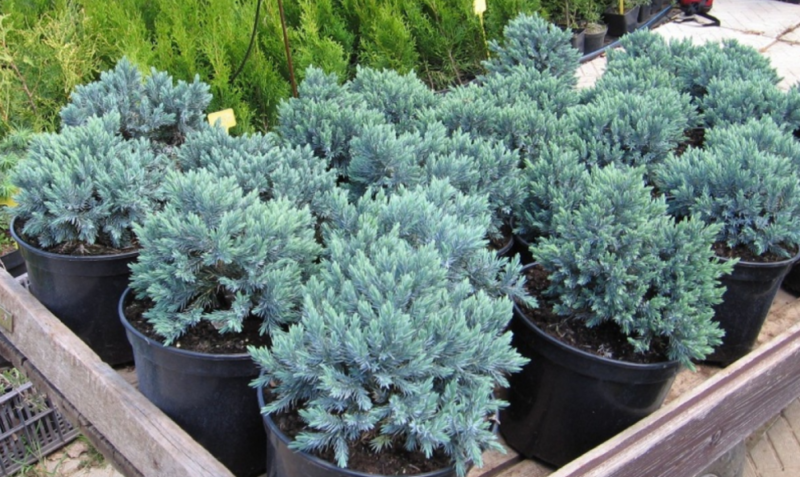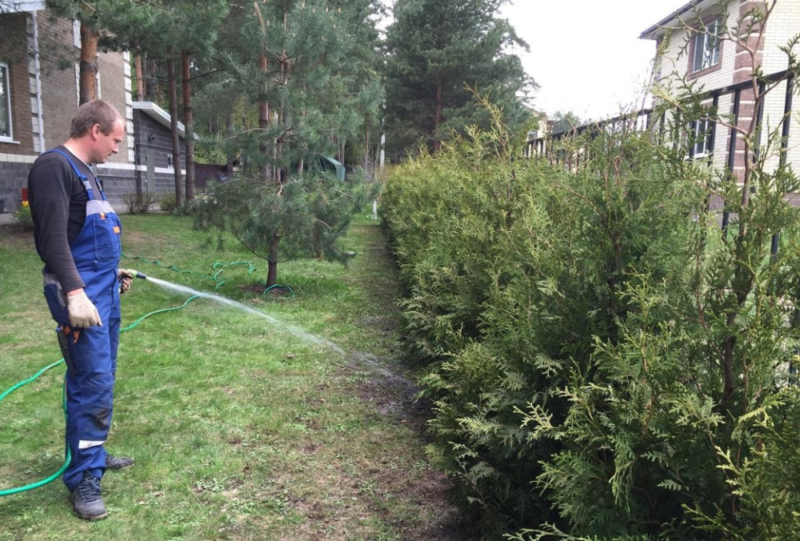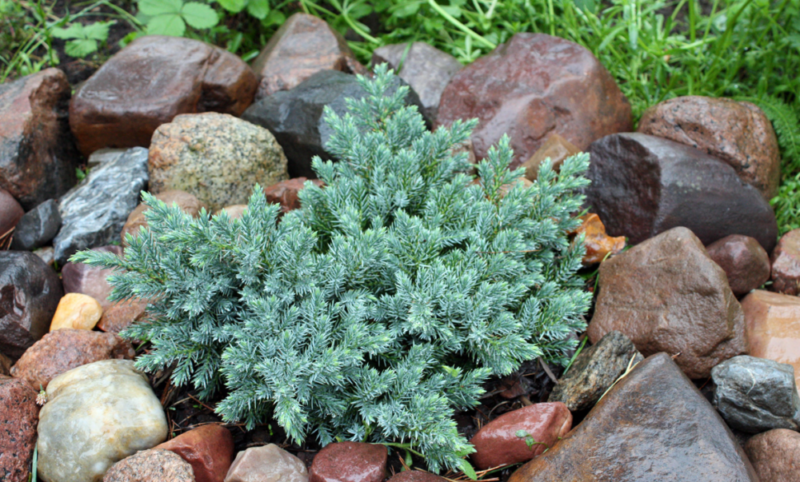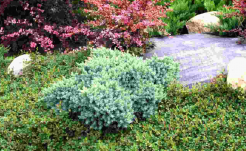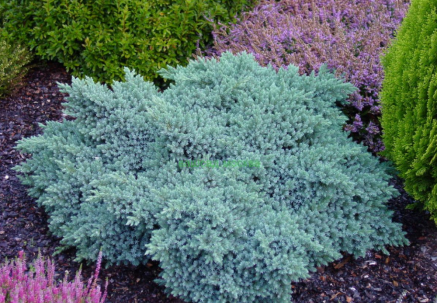The miniature juniper "Blue Star" will be a wonderful decoration for a small garden. It grows slowly and does not require frequent pruning; if desired, it can be grown in a container.
Material Content:
Description of Juniper variety “Blue Star scaly”
Blue Star is similar to the Blue Carpet variety, the difference is the gain. The first grows very slowly - from 1 to 3 cm per season. By 10 years, the bush grows to a height of 40 cm, and in breadth can grow by 2 meters. The shape of the crown resembles a hemisphere, the needles are short and prickly. The color of the needles is bluish-green with a bluish tint.
Outdoor landing
Having bought a healthy seedling in a garden center or having grown it independently from a shank, they plant it in open ground in spring or autumn. Summer planting will require shading at first and regular watering.
Prepare a hole in a well-lit area of the garden.
Junipers are usually undemanding to soils, but Blue Star is a special case. It will not grow on saline ground, heavy and clayy or constantly moistened. Ground water at the landing site should be at a distance of more than 1.5 m from the surface. Protection from cold winter winds is desirable in the form of other shrubs or walls of the house.
A hole is made larger than an earthen coma with sapling roots about 2-3 times to fill it with loose nutrient soil, in which the plant will develop well. Juniper planting is carried out in a mixture of sand, peat and compost with garden soil by transshipment.Drain from broken brick or river sand is placed at the bottom of the pit, fertile soil is placed on top, then juniper. The root neck of the seedling should be at the level of the soil. Having finished work, the hole is well watered, sprinkling a little earth on top, if it sits, then mulching is carried out with peat, sawdust, coniferous litter.
Agrotechnics of cultivation and care
The scaly juniper “Blue Star” does not like moist soil, stagnation of moisture at the roots, but does not tolerate dry air. In hot summers with little rainfall, it is watered and sprayed once a week in the evenings. After watering, a shallow loosening is carried out, weeds are removed and the trunk circle is mulched with sawdust.
Feeding is carried out every spring, using special preparations for conifers.
Fertilizer with biohumus gives good results, it can be added to the well when planting. Blue Star is growing slowly, so it needs regular nutrient intake and annual nutrition.
Blue Star does not need to trim and form a crown due to slow growth. But every spring begins with sanitary pruning, and the removal of part of the juniper shoots is inevitable. After an unfavorable, cold winter, when it is necessary to cut off dried and broken shoots, the dwarf Blue Star, instead of increasing in size, decreases. Therefore, for the winter it is advisable to cover the conifer with spruce branches and burlap.
Methods of propagation of coniferous shrubs
Coniferous ornamental plant propagated by cuttings. Broken off with a heel shoots root in a wet mixture of sand and peat. The grown specimens are planted in the garden in the spring. When planting in autumn, young bushes must be sheltered for the winter.
For cuttings, year-old shoots are suitable. You can break them off at any time of the year, even in winter. Juniper roots in a warm room.
Needles are cut off from the bottom of the stem; root formation stimulants are used to increase the chances of rooting. Lower heating also helps root growth. Humidity in the cuticle should be 100%. To do this, the seedling with the container is covered with a transparent plastic bag. You can use a plastic bottle with a cut bottom as a greenhouse. Unscrewing the cork on the neck, it is convenient to carry out daily ventilation and spraying of the handle. The air temperature in the room should not be lower than 20 ° C, the lighting is diffused.
The rooted stem will begin to give a barely noticeable increase. In the first year, it can not be planted in open ground. Grow a sapling 2 or 3 years. You can not transplant it into the garden, but leave it in a container, increasing the size of the landing capacity as the juniper grows. Together with the Blue Star container, it is easy to place in any convenient area of the garden or on the open veranda.
Pest and Disease Control
To get a healthy and well-developed coniferous shrub, you need to be prepared for the difficulties that await during cultivation. The decorativeness of some specimens is reduced due to various insects and ticks parasitizing on shoots and needles.
Common pests of junipers and methods for their destruction:
- juniper aphids - the drug Fitoverm is used for control, treatment is carried out twice with an interval of a week;
- juniper scale - “Karbofos” and other insecticides help to destroy the insect;
- spider mite - effective treatment with acaricides "Karate", "Actellik", "Fitoverm" and others;
- mining moth - the insect is afraid of the Decis insecticide, the treatment is repeated after 10-14 days.
Preventive treatment of juniper against possible pests and diseases will increase the chances of its survival and successful growth. The first spraying with a mixture of insecticide and fungicide is carried out in mid-spring, then repeated after 2 weeks.
Juniper Disease:
- Shrinking branches is a common disease that causes various pathogens. They can only be determined by laboratory means.In the spring, the needles begin to turn yellow and fall, first thin shoots dry out, and then all the rest. On the bark, you can see dark dots. To treat the infection, dried branches are cut out, treating the entire bush with fungicides.
- Trachiomycosis - a fungus from the genus Fusarium affects the juniper, leading to its rapid death. The pathogenic organism settles on the roots, penetrates the vascular walls, blocking the flow of nutrients and moisture along the trunk. The plant begins to dry from the tops of the shoots, it looks as if it lacks moisture. Having noticed the dried shoots, they are cut out, and the soil under the bush is shed with systemic fungicide.
- Schütte - the needles acquire a brown color, at the end of summer it becomes covered with dark dots, and soon falls off. For treatment, it is necessary to remove the diseased needles, spray juniper with “Quadris” or “Ridomil” several times during the season.
- Rust - a disease manifests itself in bloating shoots, and the formation of orange spores in cracks in the cortex. Matured spores of rust fungi can be carried by the wind. Depending on the type of pathogen, they affect fruit trees growing nearby - iergu, apple, pear, mountain ash. When foci of sporulation appear on the juniper, it can no longer be treated, infected shoots must be cut and burned. The remaining undamaged parts of the plant are treated with fungicides.
Juniper has few diseases, but it is advisable to recognize and treat them in time. Without timely help, plants quickly die. The spread of pathogenic fungi is facilitated by a violation of agricultural production techniques - tight planting, high humidity, shading, and the absence of top dressing.
Landscaping Ideas
In landscape design, it is best to use a miniature grade of juniper with blue needles for small rocky gardens. Blue Star can be grown in containers for a long time, the slow growth of the culture limits its decorative use.
To create a composition on a flower bed, juniper is planted in the foreground so that other plants do not obscure it.
It will look good in combination with ground cover dwarf pine forms and low decorative cereals.
Juniper "Blue Star" will decorate the landscape design of a small garden. A fragrant plant will purify the air and bring a lot of positive emotions to the owner.



